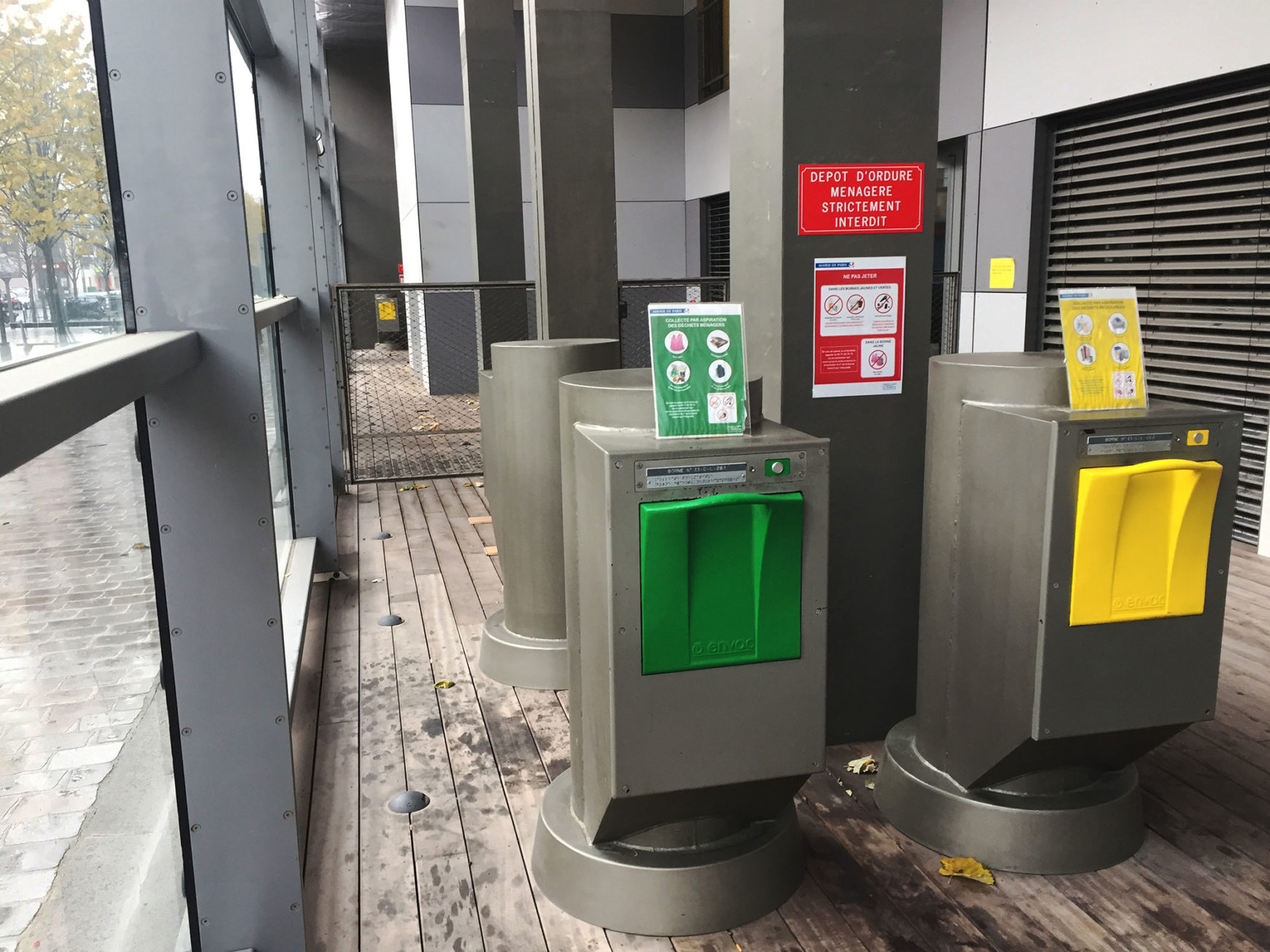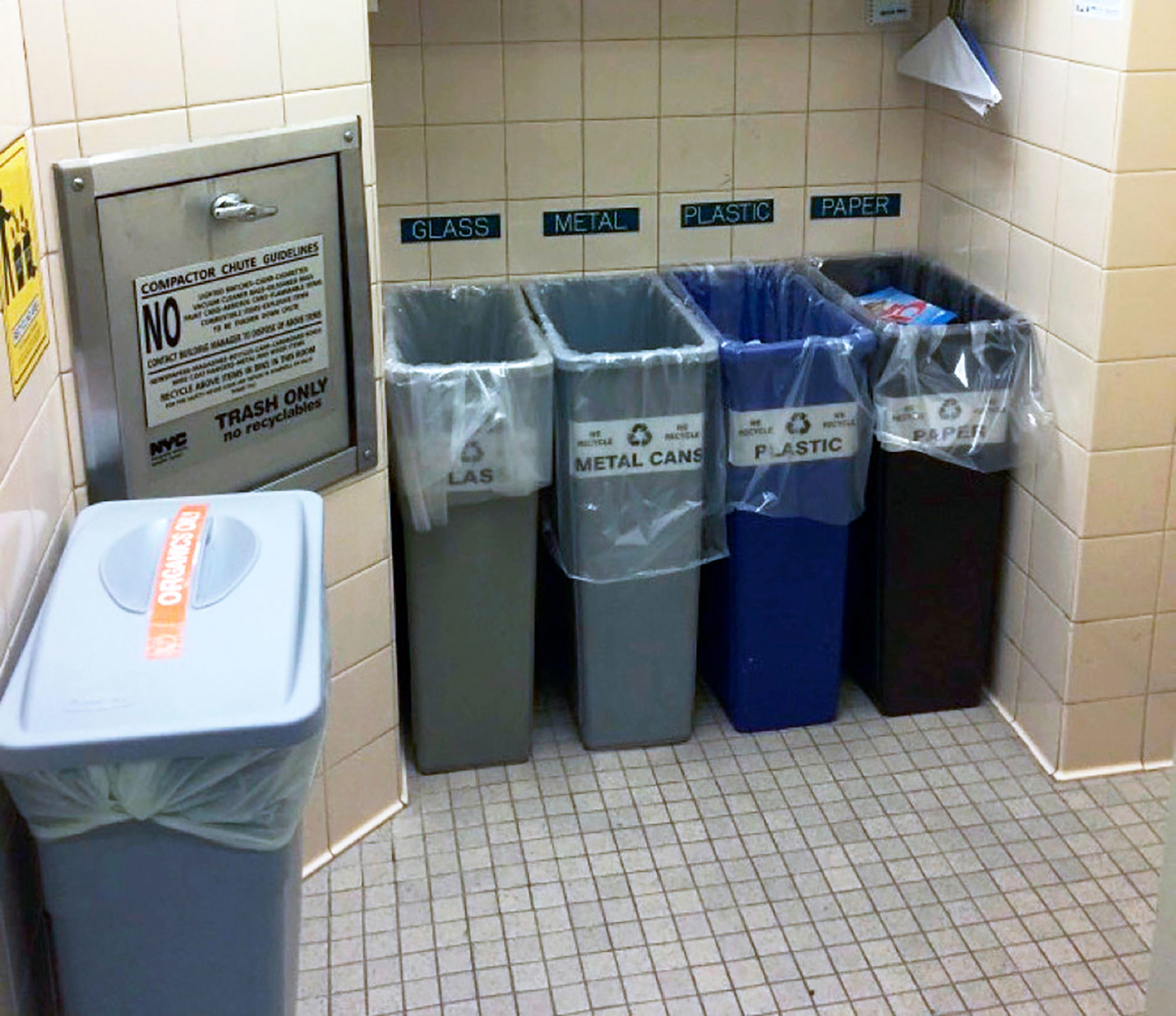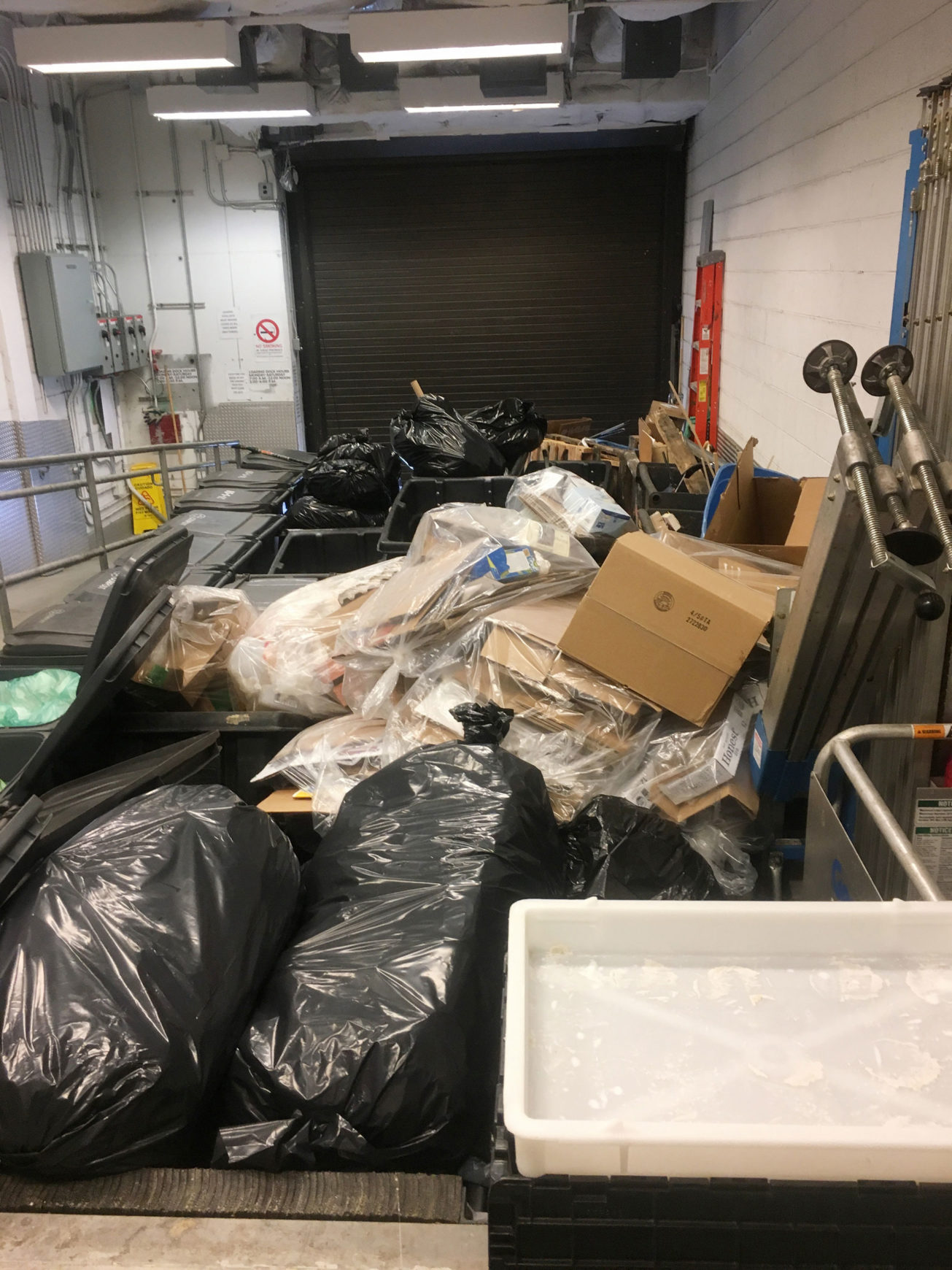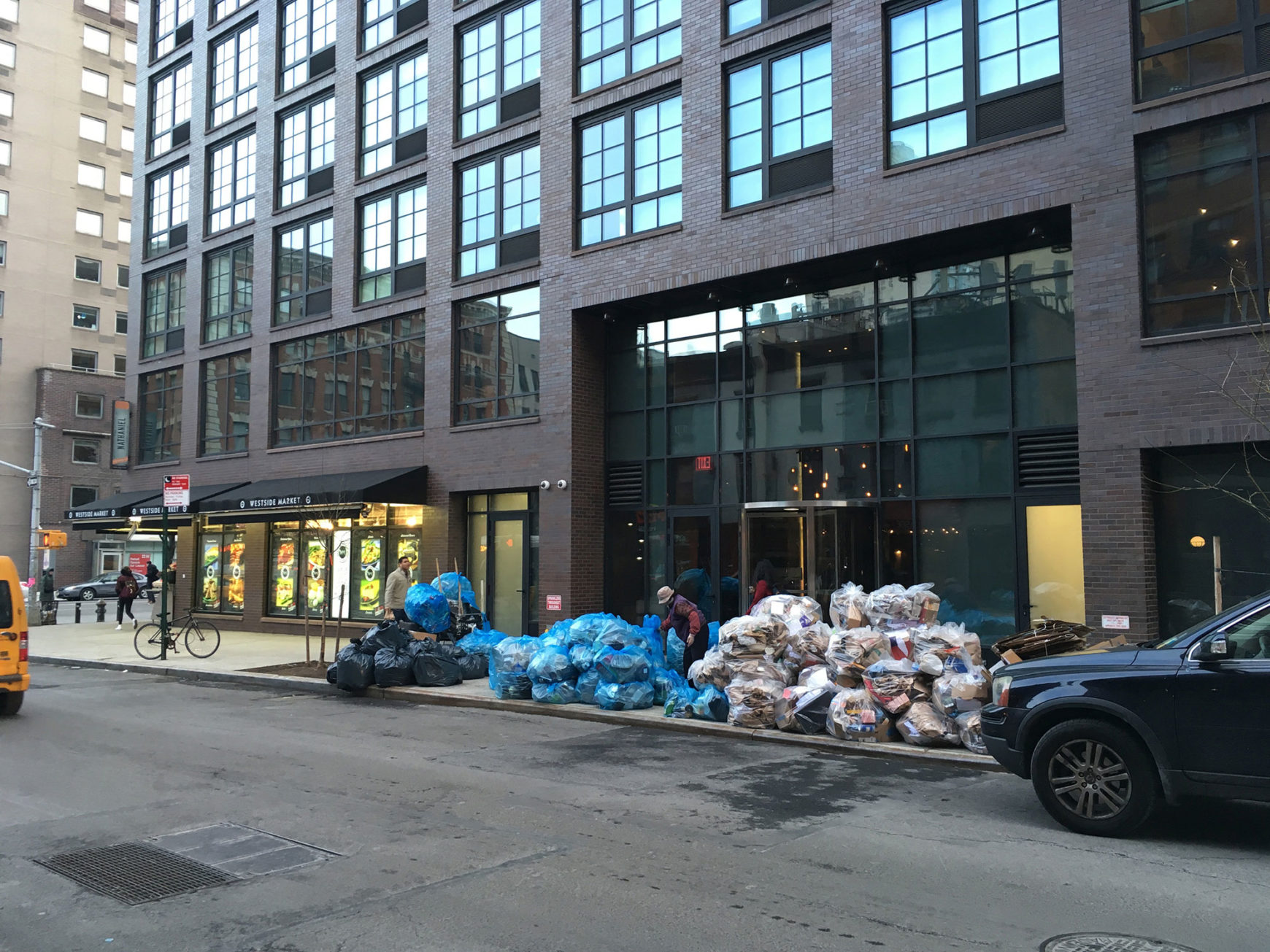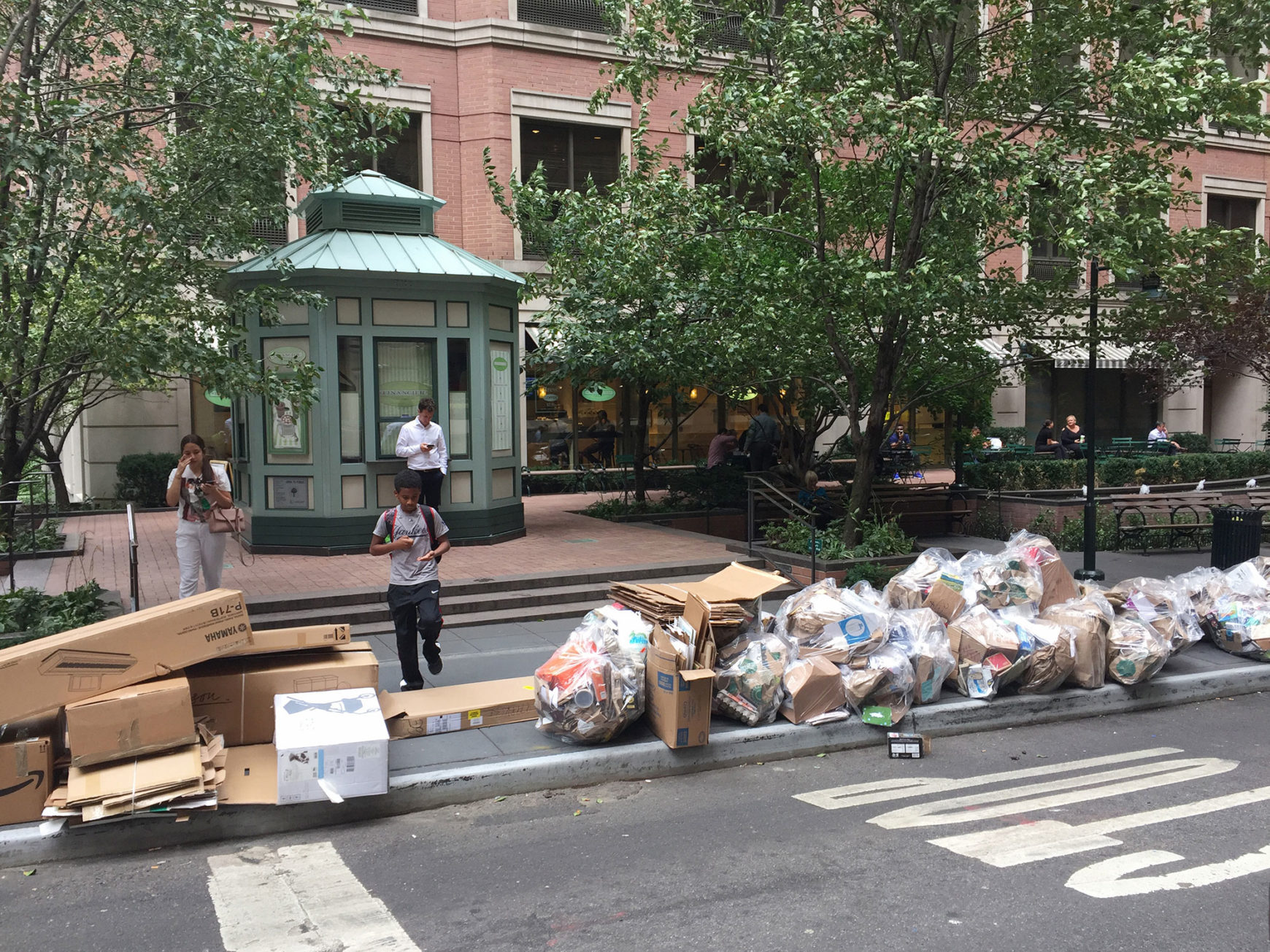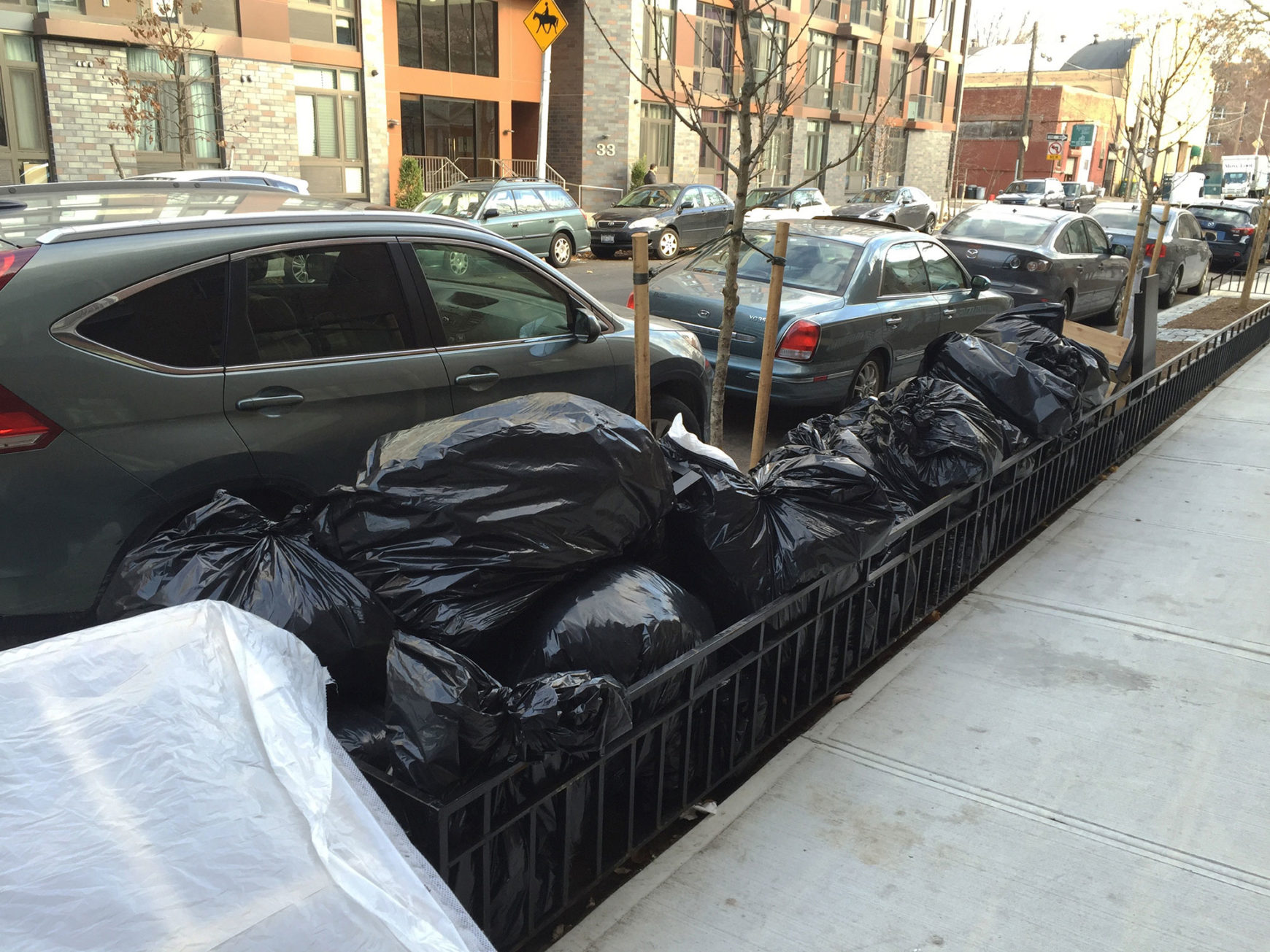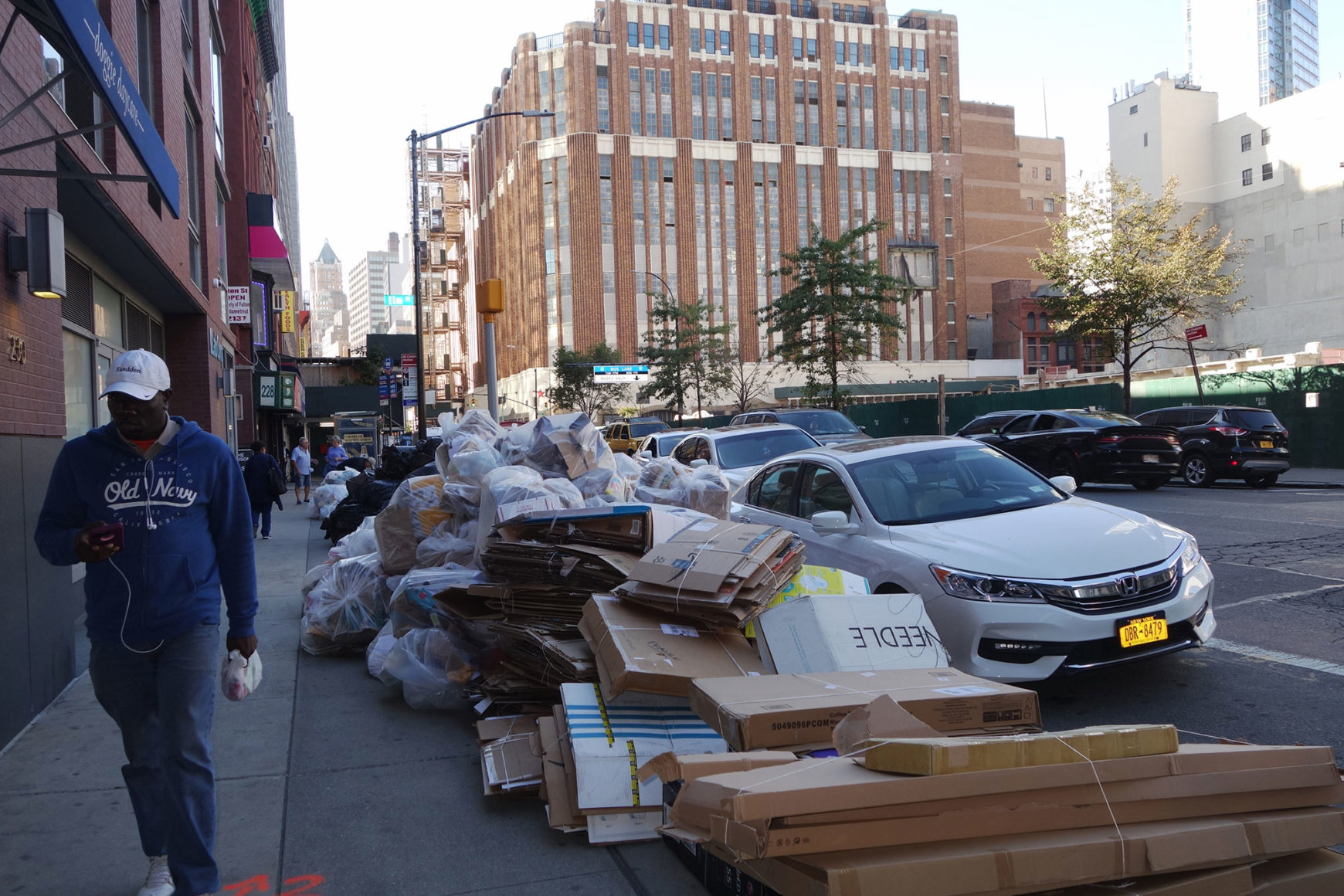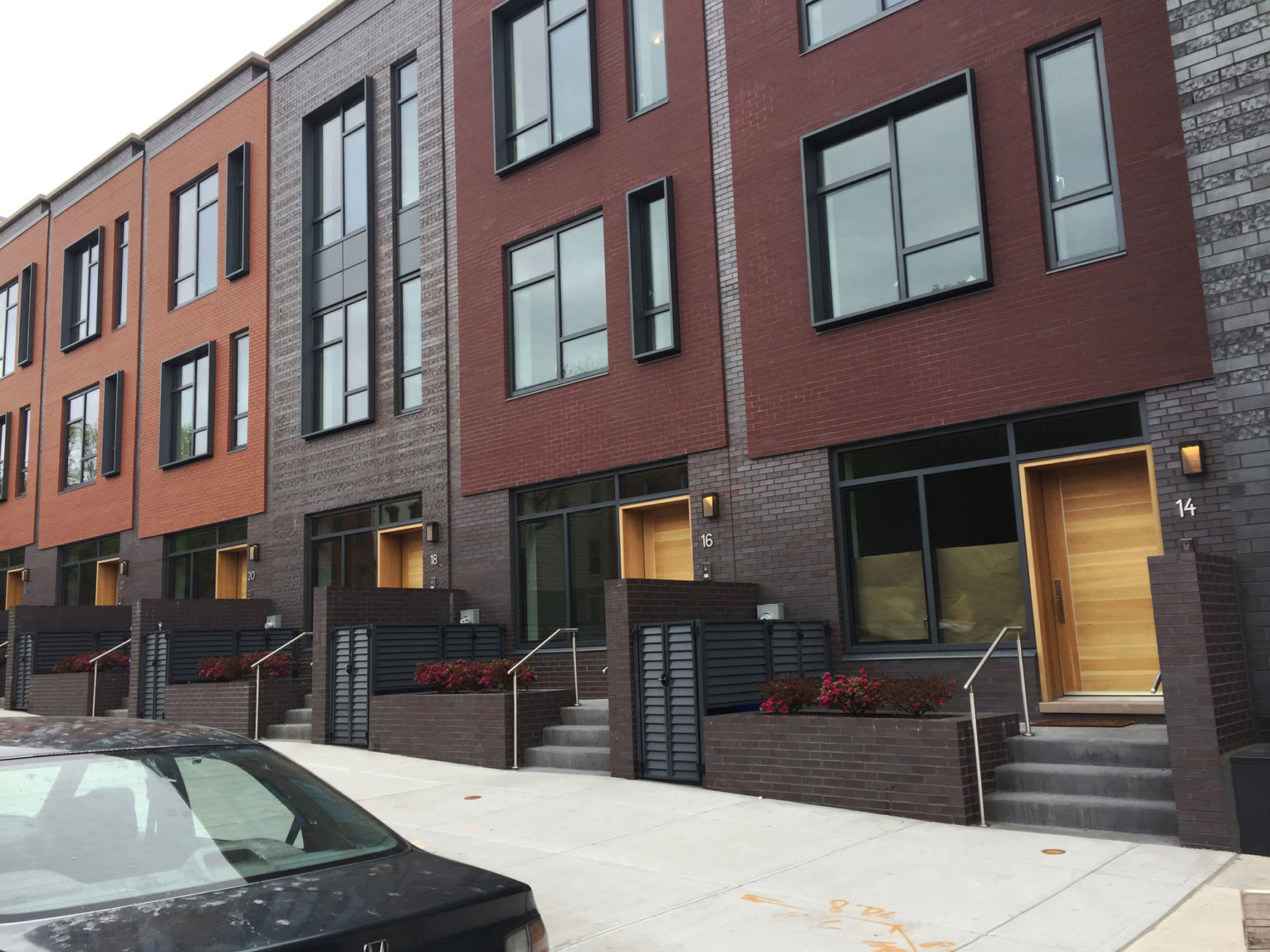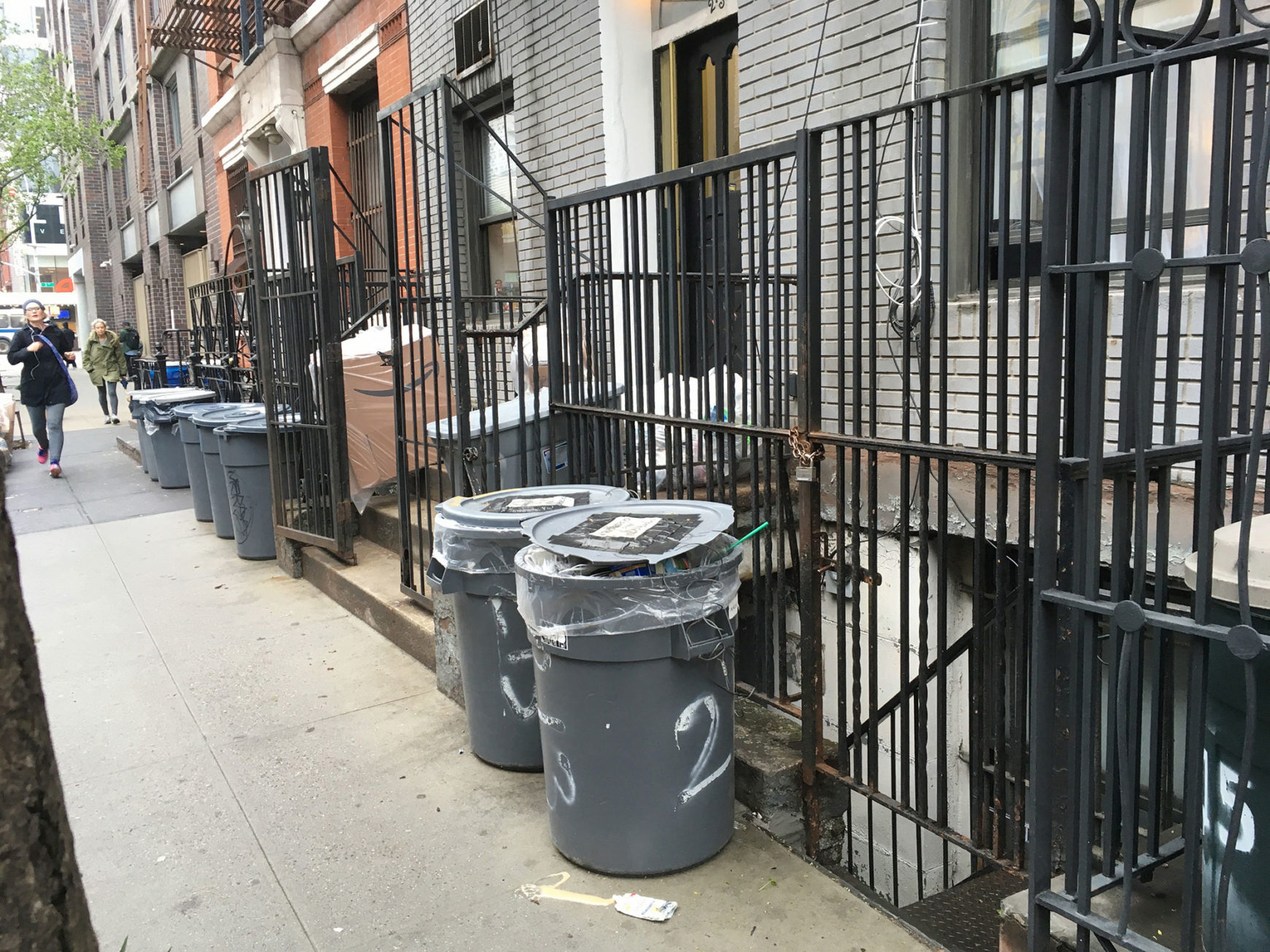The following suggestions are preliminary—further research and evaluation are needed to determine specific policies.
Building Code Provisions for Storage, Management and Setout of Waste
Proposal RC 2 of NYC’s Green Codes Task Force, released in 2010 and made law by LL 60 of 2012, was to “Provide Recycling Areas in Apartment Buildings.”
The stated summary is:
In many buildings, the lack of dedicated space for sorting and segregating recyclables impedes recycling efforts. By increasing the allotted space for recycling bins and thus increasing awareness and accessibility for recycling measures, this law will increase the recycling rates for multifamily residential buildings.
The proposal added additional storage space for refuse and recyclables and required equal convenience disposal for recycling and trash in larger residential buildings with chutes by requiring 5 sq ft of floor area for recyclables in a refuse chute access room (unless there is a chute sorter or multiple chutes accommodating recycling).
Now that the city is starting to collect organics, there should be equal convenience disposal for organic waste as well, or diversion of those materials will suffer due to reduced convenience of disposal. In other cities, such as San Francisco and Milan, equal convenience disposal has been achieved by discouraging or banning chutes.
There are two possible paths forward to create equal convenience disposal for trash, recycling and organics:
- Amend BC 1213 to require storage for organic bins in chute access rooms with sufficient ventilation. For this approach, porters would need to service the bins often enough to avoid odor concerns, or
- Consider removing the requirement for chutes so that all waste streams can be disposed of at a central or ground-floor location. This would allow for reduced staffing as well as easier oversight of the waste disposal, which may lead to higher diversion rates. ← Empirical research on the effect of oversight, social pressures and convenience on recycling behavior in multifamily buildings is relatively new. See Calvin Lakhan’s “Out of Sight, Out of Mind: Issues and Obstacles to Recycling in Ontario’s Multiresidential Buildings,” in Resources, Conservation and Recycling 108 (2016): 3.
See below for a discussion of research recommendations.
- Options for equal convenience disposal: Central disposal on ground floor or waste rooms on every story
Storage Area Requirements for Residential Buildings
LL 60 /2012 also requires 1.5 sq ft per dwelling unit of storage for trash and recycling (or 1 sq ft/DU with compactor), min. 350 sq ft. Using calculations from average DSNY waste data, we do not think this is sufficient, especially with the rise in discarded cardboard.
Our Proposal
Evaluate a range of buildings and average the data to determine the optimal amount of storage space.
Storage Area Requirements for Waste in Commercial Buildings
There are currently no requirements for waste storage in commercial buildings, resulting in all waste being set out on sidewalk for hours, or waste taking over loading docks and pushing loading to the street.
Our Proposal
Require that a certain amount of storage space is provided per square foot of commercial space, possibly varying by occupancy.
Waste Management Plans for All Buildings
There are currently no requirements for storage and planning for waste management in buildings, or for equipment for reducing volume. Some municipalities require a waste management plan be submitted before buildings are approved. Typical plans include materials characterization; allocated square footage for storage of daily waste streams and bulk materials; plan for collection, separation and movement of materials from initial disposal to set out; and reduction programs and equipment. ← For an example of a waste management plan requirement, see the City of Vancouver, BC’s “Zero Waste Design and Operations Plan,” in Rezoning Policy for Sustainable Large Developments (2014): 14, link.
Our Proposal
Make a building waste management plan part of DOB’s building approval process.
- Storage in loading dock pushes loading onto the street
Builders’ Pavement Plans to Indicate Setout Space for Waste Collection
Builders pavement plans (BPP) are required for all work resulting in a new or amended Certificate of Occupancy. Such work requires improving or refurbishing the sidewalk and portions of the street facing the building. These public rights-of-way are primarily under the jurisdiction of DOT, so the BPP needs to adhere to those standards. The BPP needs to show sidewalk details such as curb cuts and grading, all sidewalk obstructions, street penetrations and encroachments, but there is no requirement for showing temporary storage of waste, which is allowed to stay on the sidewalk from 4 p.m. to 9 a.m.
Our Proposal
BPP to show setout space for waste based on calculations of the volume of waste generated. See BPS 2.04.
Zoning Resolution Changes to Require and Incentivize Provision of Space and Equipment for Managing Waste
Currently the zoning resolution has a few sections governing refuse. In some cases, it gives floor area deductions for waste rooms; in others, it requires or disallows refuse storage, or requires screening for refuse storage.
Zoning changes are a powerful tool for shaping a city’s development. Requirements for compaction, containerization and floor area storage for waste can be evaluated, to understand whether zoning inhibits these best practices, or could be used to incentivize them. Collection of waste data from buildings employing these best practices can be compared with other buildings’ and used to develop policy changes. Existing precedents and case studies from other cities should also be examined.
- Unplanned setout
Requiring Containers and Compaction for Large New Developments
Our Proposal
Require the use of compaction and 20–40 cu yd containers for waste streams in large new developments. This would reduce the impact on public space on the street and reduce the volume of waste (see Chapter 3 Recommendations).
Floor Area Deductions for Waste Storage
Current floor area deductions are only for dumpster storage that’s adjacent to loading docks in the Manhattan Core, or for trash rooms
in quality housing developments. Increases in floor area deductions or floor area ratio are often used as incentives to encourage developers to include public amenities such as plazas or for inclusionary or affordable housing.
Our Proposal
Provide further floor area–based incentives for waste management.
DSNY Rule Changes
Chapter 3 outlines the advantages of containerized and automatic collection. Currently DSNY only provides collection of 1–8 cu yd front-end loader (FEL) containers—also called EZ Paks—for grandfathered buildings. In the Collection workshop, a panel was held with representatives from DSNY, DOT and DCP to look at ways to further containerized collection. ← While front-end load trucks are prohibited from attaching snowplows, snowplows can be added to rear-end load trucks equipped for semiautomatic collection of containers and wheeled bins.
Our Proposal
- Continue to work with DSNY to consider a policy change to allow collection of 1-8 cu yd containers in new developments.
- We understand that the following ideas are being considered by DSNY as part of the commercial zoning proposal, and we support them:
- For commercial businesses, require transparent pricing per waste stream to incentivize waste reduction. This should be passed through to individual generators in multi-tenant buildings with shared waste facilities (similar to the submetering of electricity and other utilities).
- Large waste generators should be required to conduct waste audits.
Multiagency Process to Move Toward Containerization and Automated Collection, Considering Streetscape Design and Logistics (MOS, DSNY, DOT, DCP)
The conversations started in the workshops, during which DCP, DOT, DSNY, Royal Carting representatives and advisory committee members explored possible changes to street design. These changes would require a move toward containerized and automated collection, as well as on-street siting of permanent waste collection infrastructure. The multiple challenges include to rodent-related issues, resident opposition to siting and maintenance.

Collection workshop
“The dialogue between parties was valuable.”
—Sem Sepulveda of DSNY
“I found the interagency collaborations key.”
—Kate Mikuliak of DOT
We propose that a working group with representatives from city agencies and private stakeholders look at:
- Street and sidewalk rules to allow automated collection and use of public space where necessary for containers. This would consider using parking spaces, curb extensions and other means to create permanent and temporary storage for containers.
- Expansion of drop-off sites for low-volume fractions (textiles, e-waste, go-boxes), which could be achieved with temporary or permanent solutions that build on DSNY’s ongoing expansion of the organics drop-off program with more permanent infrastructure.
- Insights from the freight working group findings—to develop solutions that solve problems of increased deliveries and discarded packaging materials.
- Design of containers that work well and enhance streetscapes.
- Solutions with benefits for building owners, such as combining loading space or temporary parking with a shared container to head off opposition to placing waste collection facilities in front of a building.

Street seats in parking lane
Multi-Stakeholder Process With MOS, UGC, AIANY, DSNY, DDC, Contractors and Developers to Devise Construction and Demolition Waste Reduction Policy
As part of the development of the guidelines, AIANY worked with Urban Green Council on developing Green Codes Task Force proposal RC2 on C&D waste. A group of stakeholders— among them, architects, interior designers, representatives from the carpet industry and major manufacturers, local reuse and carpet recyclers, contractors and city agencies—joined forces to understand the possible life cycles of carpet available today and the potential for moving to circular material flows. The process aimed to gather information to create a successful policy that would work toward a circular carpet economy.
Our Proposal
- Form a working group to develop policies for further discarded material streams, such as ceiling tile and gypsum wallboard, that would allow for more diversion.
- Offer innovation grants to help develop circular material loops, which could lead to materials such as concrete with recycled glass pozzalan as a cement replacement. (See Building Product Ecosystems.)
- Develop a path to move the built environment into the circular economy by combining lessons learned from strategies developed elsewhere with an understanding of the NYC context.
- Consider requiring a deposit payment for demo permits for C&D waste, which would be returned if diversion targets were met (see Construction & Demolition Waste Context).
- Planned enclosures for waste bins at Navy Green by FXFOWLE Architects; waste bins stored on street on 9th street
Share this page Next Section: Research Recommendations →
